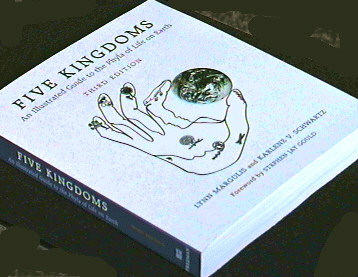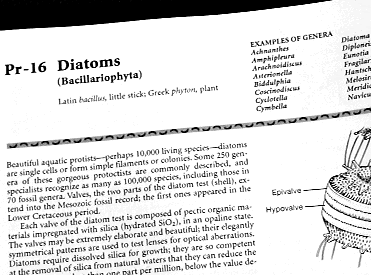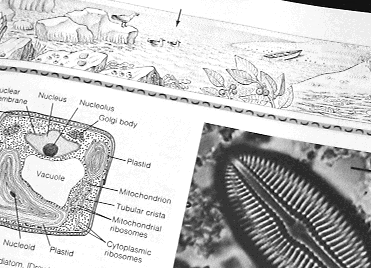 Book Review
Book Review Book Review
Book Review
Five Kingdoms - An Illustrated Guide to the Phyla of Life on Earth
by Lynn Margulis and Karlene V Schwartz
Third Edition, 1998
(ISBN
0-7167-3026-X h/b,
ISBN -7167-3027-8 p/b, 520pp.) See Footnote.
Publisher's
image copyright notice.
From: FIVE KINGDOMS: AN ILLUSTRATED GUIDE TO THE PHYLA OF LIFE ON
EARTH 3/E
by Margulis and Schwartz © 1982, 1988, 1998 by W H Freeman and
Company,
ALL RIGHTS RESERVED.
(Book cover illustration based on a sketch
by Dorion Sagan,
with design contributions from Donna Reppard).
Phyla are the major groups below kingdom level used for classifying all animal and plant life. 'Five Kingdoms' in its earlier editions is well known for providing an illustrated overview of the phyla of life on earth. This, the third edition, brings the classification up to date with various new additions to the content.
The potential appeal of the book to the amateur naturalist and microscopist is primarily covered. (Reviewed by David Walker).
Introduction
Structure
Presentation
Comparison with the Second Edition (1987)
Notes on the Content
Conclusions
Acknowledgements, Footnote, On-line ordering
Introduction
Try this quick quiz. What phyla do the following organisms belong to: man, spiders and liverworts. If you answered Chordata, Arthropoda and Bryophyta you're a little out of date ... like the reviewer! If you answered Craniata, Chelicerata and Hepatophyta, well done you've kept abreast of modern taxonomy.
It may seem surprising that some of the major phyla such as those above can undergo extensive revision, but this in part is a reflection of the modern advances in our understanding of the relationships between organisms and their ancestry.
A third edition of 'Five Kingdoms', eleven years after the second, is thus very welcome to bring these changes to the attention of a wide audience. However, as with previous editions, the book is more than just an up to date summary of life at phylum level, the authors have succeeded in producing a celebration of the wonderfully diverse forms that life on is earth is manifest, from the tiniest bacteria to the largest mammal.
The publishers describe the book as 'an extraordinary, all-inclusive catalogue of the world's living diversity' and is intended for students of biology at all levels of expertise both professional and amateur. The book certainly deserves a wide readership.
Structure
The book's title 'Five Kingdoms' refers to the major kingdoms into which animals and plants are currently classified by most authorities. See David Goldstein's article in Micscape May 1998 for an overview of the classification of living things.
A detailed synopsis of the book's structure, detailed phyla list and the additions since the second edition is given on the publishers web site, so is not described in detail here. The overall structure is as follows.
Foreword by Stephen Jay Gould and Preface by the authors
Introduction - classification, the five Kingdoms of life, molecular systematics, historical aspects of taxonomy, tips on using the book. Includes a list of 'field trips' in museums and parks world-wide and 'virtual field trips' i.e. a selection of useful web sites.
Chapter 1 - Kingdom Bacteria, 14 phyla
Chapter 2 - Kingdom Protoctista, 30 phyla
Chapter 3 - Kingdom Animalia, 37 phyla
Chapter 4 - Kingdom Fungi, 3 phyla
Chapter 5 - Kingdom Plantae, 12 phyla
Appendix - list of phyla, genera assigned to phyla
Glossary
Index
Each of the Chapters 1 to 5 include an introduction to the kingdom and bibliography. Each Chapter is headed by 'a phylogeny - a diagram showing the likely evolutionary relationships among the phyla of that kingdom'.
Presentation
A book that provides an overview of the many life forms on earth with a survey of their classification, runs the risk of being a very dry book. 'Five Kingdoms' is far from being dry, as clearly a lot of thought has gone into producing this attractive book. It invites being delved into, rather than being relegated to the shelf as a worthy tome to have as a reference but not read. The attention to detail starts on the front cover. As with the second edition, a stylised human hand with fingers and thumb representing the five kingdoms encompasses the earth and is an attractive visual summary of the contents.
Overall the presentation is excellent and a nice blend of styles and layouts makes it very readable. The line drawings are very crisp and clear with enough detail to show the features of an organism but without too much to make them look cluttered. The majority of photographs taken from many sources (all black and white) are also to a high standard. Many of the macroscopic as well as microscopic organisms were photographed with an SEM to give a crisp depth of field.
I suspect the publishers have gone for the very open layout to lighten the look of a potentially 'heavy' book, which is to be commended from one point of view but this has created quite a number of almost blank pages at the end of many phylum entries (see later comment under Content).
 The image left shows the typical layout
adopted for the first page of each phylum. Each phylum is
assigned a number and synonyms for the phyla are included in
brackets. ('Pr' in this example denotes the Kingdom Protoctista).
(Note that plant phyla are referred to by many botanists as
divisions but are described as phyla in this book for
consistency). Examples of genera are included for each phylum,
which are cross referenced with the alphabetical genus list at
the end of the book. (Drawing by E. Hoffman).
The image left shows the typical layout
adopted for the first page of each phylum. Each phylum is
assigned a number and synonyms for the phyla are included in
brackets. ('Pr' in this example denotes the Kingdom Protoctista).
(Note that plant phyla are referred to by many botanists as
divisions but are described as phyla in this book for
consistency). Examples of genera are included for each phylum,
which are cross referenced with the alphabetical genus list at
the end of the book. (Drawing by E. Hoffman).

Image right shows a typical layout of the facing page for each phylum (in this case Diatoms). An environment scene heads the page with arrows showing the typical habitats of the organisms in the phyla. Seven scenes have been designed for use in this edition (cf. five scenes for the second edition). (Drawing by L. Meszoly).
Comparison with the Second Edition
Readers familiar with the second edition published in 1987 will find the format, structure and overall content of the third edition very similar. Some phyla have undergone extensive revision but not surprisingly many of the phyla essays are very similar to the previous edition. The majority of illustrations are also common to the earlier edition. The detailed list of additions and changes are given on the publishers web site.
The most noticeable difference is the expanded and now illustrated introductions to each of the Five Kingdom chapters.
Although barely eleven years have elapsed since the second edition, the pace of progress in our understanding of taxonomy and systematics, (particularly molecular systematics), is evident by the fact that some of the phyla most well known to us seem to be those undergoing most revision. The book's Preface discusses the background to these revisions. Here are a few examples (2e = 2nd edition, 3e = third edition).
Here are a few examples of changes in classification since the second edition (published in 1987) and the new third edition (referred to as 2e and 3e respectively below).
Arthropoda
- a phylum in 2e and includes the subphyla (or superclasses)
Crustacea, Uniramia and Chelicerata
- in 3e the three subphyla above are each now phyla (i.e.
Arthropoda is no longer a phylum)
N.B. Uniramia (or Mandibulata) includes the Class Insecta and
Chelicerata includes the Class Arachnida.
Chordata
- a phylum in 2e
- in 3e Chordates are split over three phyla i.e. Craniata
(includes mammals), Cephalochordata (includes Amphioxus),
and Urochordata (sea squirts)
Bryophyta
- a phylum in 2e and mosses, liverworts and hornworts assigned
separate Classes
- in 3e bryophytes are split over three phyla i.e. Bryophyta
(mosses and Takakia), Hepatophyta (liverworts) and
Anthocerophyta (hornworts).
Notes on the content
There is plenty to interest the microscopist or anyone interested in the smaller life forms in this book. All the phyla are assigned at least two pages so even the smaller phyla, many which include microscopic organisms in the Protoctista and Bacteria, get good treatment. This ensures there is a feast of drawings, photographs and succinct text descriptions of microscopic life. Each phyla can be read as a discrete section, and thus it's a pleasant book to delve into when there's a few minutes to spare, and to learn about one of the lesser known but fascinating phyla and their members.
The introductions to each kingdom before the individual phylum essays are particularly useful and give a good overview. The diagrammatic phylogeny for each kingdom also puts the phyla and their relationships into perspective. I particularly liked the essay on the Kingdom Bacteria, and the table summarising their different modes of metabolism.
It is inevitable that a book of this type will contain many specialist terms. The book is aimed at the non-specialist as well as the specialist so the extensive Glossary is very useful and the reviewer referred to it frequently. The bibliographies at the end of each chapter are also well thought out. There are both references to popular introductory works as well as more specialist works on each phyla. With the aid of the Glossary the text is certainly accessible to a wide readership, as the authors intended, with plenty of advice for further reading.
I've tried hard, but I've yet to find a typographical error in the book, the lack of them is commendable in a book of this complexity. One possible factual error was the caption to Figure D (page 76), which describes the main image of live bacteria shown as imaged with a TEM - an optical microscope seems more likely.
A minor niggle carried over from the second edition is the definition of the colophons (i.e. the icon of a human eye, hand lens, SEM, TEM etc. next to each photograph). They're defined as 'indicates the kind of optical equipment needed to see the subject of the photograph'. As an SEM was used to image a number of macroscopic creatures (e.g. Hydra, millipedes, nematodes) which can be easily studied by a naturalist with a modest stereo microscope or hand lens in the detail shown, the definition isn't strictly true, '... the kind of optical equipment used ...' perhaps would be more accurate. However, as scale bars have been meticulously included in all photographs, the reader can easily judge whether an unfamiliar organism can be studied with the equipment they possess or really does require an SEM (scanning electron microscope)!
As in previous editions, for the Phyla such as Craniata, Anthophyta (flowering plants) and Mandibulata (includes insects), I suspect the authors were faced with a dilemma. Each of these phyla contains an awesome array of diverse life forms of importance to man. Reviewing these in the four to six pages allocated to such phyla is quite a task. I think the text covers the ground well, but for some of these phyla perhaps more illustrations could have been justified to show the diversity of life forms. There is certainly room in the book's format for them (i.e. plenty of blank pages at the end of phylum entries). Some of these phyla benefit from a diagram showing the structure of the phyla to class/sub-class level (e.g. Craniata) which greatly aids an understanding of their structure. I think some of the other phyla of particular interest to a wide audience such as Anthophyta (flowering plants) could also have benefited from this type of diagram.
The essay on Phylum Crustacea could also perhaps have benefited from a labelled line drawing of a typical member of the phylum to accompany the photograph, as the other phyla essays do. It does have a line drawing of an atypical member, the Pentastomes (tongue worms) which are of interest because they have now been grouped in this phylum.
I was interested to see that Symbion pandora hasn't yet been formally assigned the new phylum (Cycliophora) that was proposed for it. This microscopic organism was found on the lips of the Norwegian lobster and attracted world-wide media attention when a paper describing it in 'Nature' was published in December 1995. This new species was such an unusual organism, a new phylum was proposed. Apparently further studies are required before Cycliophora can be accepted as a phylum, in part to establish Symbion's relationship with members of existing phyla. This is discussed in the Preface and the introduction to the Animal Kingdom chapter. (Microscopy UK has a particular 'affection' for 'Pandora', as the site had a 'scoop' when the discoverers and 'Nature' magazine generously helped us illustrate an article on Pandora.)
Conclusion
This is a very worthwhile addition to the library of anybody interested in the wonderful diversity of life on earth, and their current classification at phylum level. There is plenty of interest for the naturalist and microscopist on either an amateur or professional basis. Specialised textbooks often command high prices, but considering the wealth of information in this 520 page book it is sensibly priced i.e. £25-95 ($29.95) for the paperback.
Acknowledgements. David Walker thanks W H Freeman (UK) and Macmillan Distribution Limited (UK) for the review copy. Also thanks to Jennifer MacMillan (Permissions Co-ordinator, W H Freeman, New York) for permission to use the images.
The reviewer David Walker is an amateur naturalist and microscopist based in the UK.
Footnote: The book is also available supplied with a separate reference directory pamphlet. The pamphlet includes an annotated list of the phyla and a short description of each phylum. This version is available in paperback (ISBN 0-7167-3183-5). 'Five Kingdoms' third edition is also available in Spanish, Japanese and German. Return to review.
On-line ordering: There are a variety of excellent on-line bookstores, two are http://www.amazon.com and http://www.bookshop.co.uk.
Please report any Web problems
or offer general comments to the Micscape Editor,
via the contact on current Micscape Index.
Micscape is the on-line monthly
magazine of the Microscopy UK web
site at Microscopy-UK